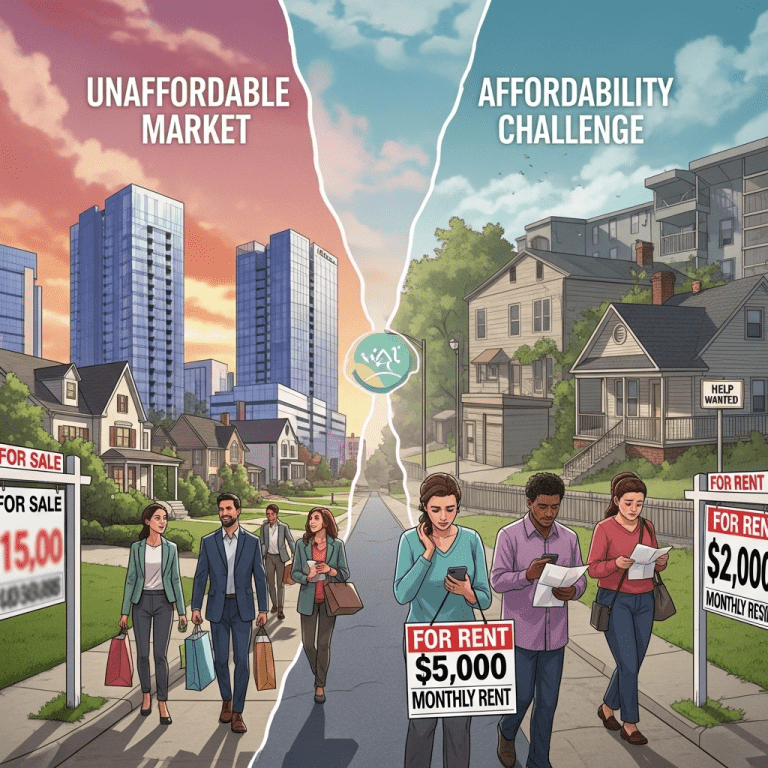As economic and demographic shifts accelerate in 2025, Alabama’s housing market reveals a growing affordability divide, leaving many residents struggling to achieve homeownership or keep up with rising rents. The evolving landscape presents both challenges and opportunities for buyers, sellers, and real estate investors throughout the state.
How Alabama’s Housing Market Reveals a Growing Affordability Divide
The past several years have brought significant changes to Alabama’s real estate landscape. Home price appreciation, mortgage rate fluctuations, and shifting demand have all contributed to the widening gap between those who can afford to buy or rent and those who cannot. Statistics from the Alabama Center for Real Estate show that while median home prices have surged by over 30% since 2020, wage growth has significantly lagged behind. This growing disparity underlines why Alabama’s housing market reveals a growing affordability divide unlike any in recent memory.
The Impact of Escalating Home Prices
One of the most visible signs of the affordability divide in Alabama is the strong upward trend in home prices. Urban centers such as Birmingham, Huntsville, and Mobile have seen new levels of demand, driven by out-of-state migration, job creation in tech and manufacturing sectors, and a severe shortage of available homes. While increased property values have boosted the net worth of some homeowners, first-time buyers and low-to-moderate-income families face unique barriers. Competition for limited inventory often results in homes selling above the asking price, pushing more buyers out of the market entirely.
Rental Market Squeezes Lower-Income Residents
The divide extends to the rental sector as well. Statewide, rents have risen 20-25% in the past three years, according to industry data. For Alabamians who cannot afford a down payment or qualify for mortgage financing, elevated rents consume a disproportionate share of household income. In some communities, more than a third of residents spend over 30% of their income on housing, meeting the federal definition of being “cost-burdened.” This is a stark sign of how Alabama’s housing market reveals a growing affordability divide that impacts daily life for thousands.
Regional Disparities and the Urban-Rural Divide
Affordability issues in Alabama are not experienced equally across all regions. Metropolitan areas, especially those near major employers or universities, tend to see the highest price growth and most acute shortages of affordable housing. Meanwhile, rural counties may have stagnant real estate markets or even declining prices, yet residents still face affordability obstacles due to lower average incomes and limited housing stock.
Migration Patterns and Local Economies
Migration patterns are contributing to the complexity of Alabama’s housing affordability divide. Many young professionals and retirees are attracted to growing metro areas, intensifying demand for both single-family homes and apartments. As a result, communities such as Madison and Shelby Counties are seeing double-digit price increases and heightened competition for every listing. These housing crunches are reshaping local economies and driving investment in new developments—but often at price points that exclude many long-term residents.
Driving Factors Behind the Affordability Crisis
Several factors are fueling the growing affordability divide in Alabama’s housing market:
- Limited housing inventory: A decade of underbuilding, labor shortages in construction, and supply chain disruptions have left Alabama with far fewer homes than needed to meet current demand.
- Rising interest rates: Increases in mortgage rates since 2022 have made monthly payments significantly higher for new buyers, reducing affordability across the board.
- Stagnant wage growth: Many sectors in Alabama have seen only modest income gains, lagging far behind the cost increases for both owned and rented housing.
- Inadequate affordable housing policies: State and local efforts to stimulate the construction of affordable units have not kept pace with population growth or market dynamics.
An additional layer to this divide is the demographic disparity. Minority and younger households are disproportionately affected, with Black and Hispanic homeownership rates remaining far below those of White residents, reinforcing generational gaps in wealth and stability.
Solutions and Future Outlook for Alabama’s Housing Market
While the challenges are significant, stakeholders across the state are calling for creative solutions to address Alabama’s growing affordability divide. Recent proposals include incentivizing the construction of affordable housing, reforming zoning and land use policies to encourage denser and more varied development, and expanding state support for renters and first-time buyers. Programs aimed at boosting financial literacy and down payment assistance have also gained momentum thanks to public-private partnerships.
Opportunities for Investors and Homebuyers
Despite the hurdles, the evolving landscape in Alabama’s housing market creates opportunities for thoughtful investment. Local real estate investors and homebuyers can leverage emerging data and market trends to identify undervalued neighborhoods or up-and-coming suburbs. For those interested in learning more about market dynamics and investment strategies, resources like real estate investment guidance have become invaluable.
Conclusion: Navigating the Path Forward
As Alabama’s housing market reveals a growing affordability divide, the need for collaborative, forward-thinking solutions has never been more urgent. Bridging this gap will require the combined efforts of policymakers, community leaders, developers, and residents. With rising awareness, targeted interventions, and informed participation, Alabama’s communities can work toward a more equitable and accessible housing future for all.
Stay informed, explore new strategies, and consider seeking up-to-date information from trusted industry sources as you navigate Alabama’s complex and rapidly changing housing landscape in 2025.









